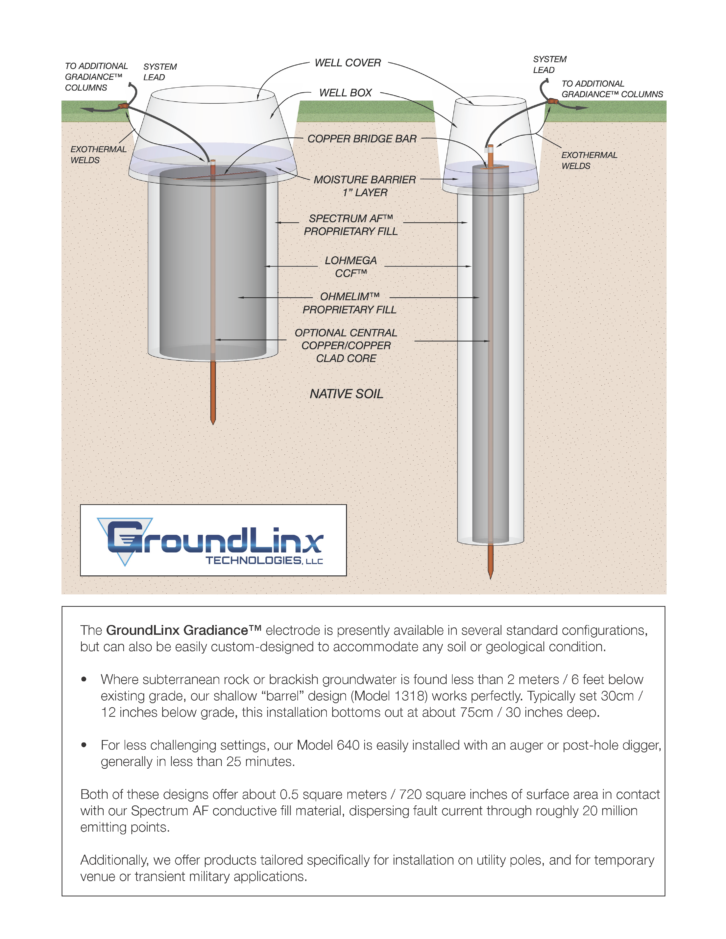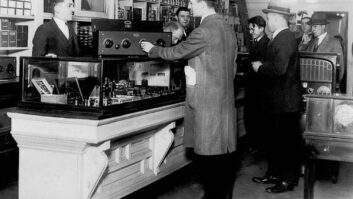
Tom LaBarge is CEO of GLxT Holdings and its manufacturing subsidiary GroundLinx Technologies. The company makes a system called Gradiance that it promotes as providing a new approach to electrical grounding.
Radio World: Don’t we know pretty much what we need to know about grounding?
Tom LaBarge: The necessity for electrical grounding has indeed been well known for over two centuries. But well known and well understood are not always synonymous.
The current industry specifications to achieve compliance in a grounding installation are woefully outdated and dangerously anemic with respect to the electronics-rich culture of contemporary society.
Even “enhanced” grounding systems exclusively rely on a humble ground rod — inspired by Ben Franklin — which, in fact, has only a single point of primary dissipation for fault currents, as well as no capability for high-frequency dispersion.
Regardless, engineers continue to specify not only antiquated technology, but also inaccurate models of grounding performance and on point-in-time resistance-to-ground measurements made with low-voltage, low-frequency test equipment.
“Significant research is now available that shows dissipation of dangerous fault currents can be accomplished very successfully if novel combinations of new materials and electrode structures are employed.” — Tom LaBarge
These meters cannot capture the dynamic characteristics of an entire fault event. Thus, the limitations of basic ground rods, combined with grounding system designs built only to achieve snapshot-quality resistance measurements, result in much less than optimal protection of the broadcasting plant.
However, significant research is now available that shows dissipation of dangerous fault currents can be accomplished very successfully if novel combinations of new materials and electrode structures are employed.
Such designs can properly manage high frequencies in these currents, as well as more efficiently disperse all aspects of a fault pulse over time through better management of differences of impedance in elements of a grounding system.
Existing technology — as discussed within the broadcasting industry for many years — is not able to achieve these essential results, thus causing increasing failures of critical equipment.
In fact, there is a tremendous amount of new information to review and understand with respect to effective grounding — particularly as the financial and operating demands of broadcasters evolve.
RW: You’ve said systems can fail “in spite of their adherence to commonly accepted design standards.” It sounds like the standards themselves need to change, no?
LaBarge: We absolutely advocate for standards to be changed — based on a new understanding of fault current characteristics, dramatic limitations of present grounding technology and the shortcomings of contemporary grounding system analysis techniques.
The quantity and sophistication of electronics required in broadcasting of any type, whether commercial, public safety, industrial or transportation, among many other uses, has leapfrogged the published performance goals of traditional grounding. We seek to be the change agents toward substantially improving protection of expensive equipment, and reduction in injuries and loss of lives.
RW: Your GroundLinx Gradiance system aims to provide a solution. What is it?
LaBarge: Through the use of novel combinations of materials not previously found in grounding devices, these products are capable, first, of non-sacrificially dissipating current frequencies exceeding 60 MHz, the point where copper begins to lose effectiveness, and second, creating an “impedance gradient” that dramatically reduces the possibility of reflection of a fault current, throughout the event, back into systems and devices that a grounding strategy was designed to protect.
Traditional ground rods are not able to offer these protective features. With GroundLinx Gradiance systems we’ve reimagined and redesigned the “business end” of grounding to protect the super-sensitive electronics of the contemporary broadcast plant at a significantly higher level.

RW: What are the major deficiencies in common grounding systems?
LaBarge: In a nutshell we can group major causes of the significant deficiencies into two megacategories: absence of research and development over several decades, and a general lack of understanding of the physics behind grounding performance overall. Additionally, within the world of traditional grounding, there is little consensus on system design standards.We’ve heard it said that if one puts 10 grounding design engineers in a room, 11 opinions will emerge.
In terms of industry codes, grounding has always been an exercise, necessary to achieve a stated resistance-to-ground target — which is of very limited value with respect to true, full-fault-event dissipation. This rote activity is repeated all over the world. As a result, the U.S. insurance industry alone reports over $1 billion in lightning losses every year. (This excludes fire damage initiated by lightning.) European Union organizations site “billions of Euros” lost annually due to lightning and fault current events.
Due to antiquated modeling, inaccurate representations of fault current behavior and a “We’ve always done it this way” attitude, the use of everything from highly insufficient conductor size or deployment, to exclusive reliance on soil moisture, to creation of “ground loops” that allow fault currents to return to structures and equipment, the range and amount of dangerous errors in grounding system design are rather amazing.
As an example, at a recent site inspection at an eastern U.S. larger-market television tower, three chain-link fence posts embedded in concrete were being used as grounding for this tower more than 1,000 feet tall. Not surprisingly, the facility suffers equipment damage exceeding $50,000 annually.
Reviews at smaller-market radio facilities nearly always show major disregard for grounding necessities. As a result, off-air time, or signal disruption events at a minimum, are far too common.
In all cases, the throttling of major fault currents into small ground rods, regardless of quantity, that have a huge disparity in impedance relative to surrounding soils (and possibly amendments) far too often results in completely insufficient dispersal of the fault, and therefore equipment damage, or worse.
We see this situation in well over 90% of the sites we review.
In our experience, U.S. broadcast facilities of all types and applications are generally designed to achieve compliance with the current published standards and codes. They are often tested and certified to comply with specified static/point-in-time resistance-to-ground readings. However, as I said, such measurement is only a snapshot of system performance made with simple test meters — which cannot emulate the performance of a grounding system over time during a major fault event where over 30,000 amps and 250,000 volts at frequencies exceeding 200 MHz may be encountered.
Broadcasters need to up their grounding game, and do so quickly.
RW: What else should we know?
LaBarge: Steep waveforms at the initiation of lightning strikes and fault surges are now understood to contain a simultaneous mélange of frequencies that often exceed 100 MHz. It is the inability to deal with this toxic onslaught that is often to blame for signal loss, equipment damage and worse. Immediate dissipation of the high-frequency barrage — before its reflection back into equipment can occur — is paramount. Unfortunately, copper is only optimally effective up to 60 MHz, and loses effectiveness quickly above that level. Therefore, rethinking of grounding system materials and structures, and overall grounding strategies, is necessary.
Quite simply, the “criticality” of greatly improved grounding in broadcasting operations through attention to fault frequencies and grounding impedance mismatches cannot be overstated. For operating consistency and financial prudence, we encourage radio broadcasting engineers to become far more “acquainted“ with grounding systems of their facility.
Information about the company’s grounding systems can be found at www.groundlinx.com.
Radio World welcomes comments on this or any story. Email [email protected] with “Letter to the Editor” in the subject field.












